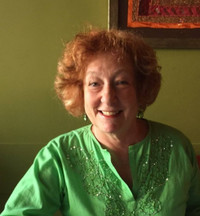Dr. Carol Zemel
Peacefully on November 21, 2021 in her 80th year, at Elizabeth Bruyere Hospital in Ottawa.
Dr. Zemel is the daughter of Joseph W. Moscovitch and Beatrice (nee Rebecca) Greenblatt, both previously deceased.
She is survived by her brother Jack Grant, her sister-in-law Suzanne Wicks Grant, her niece Rebecca Alexandra Grant, her cousins Ira Greenblatt and wife Danielle Dugas-Greenblatt, Lynn Greenblatt, Jacqueline Greenblatt and Miriam Greenblatt.
Dr. Zemel was born in Montreal, and lived variously in New York City, Philadelphia, Buffalo and Toronto.
She was a university professor. She taught at the State University of New York at Buffalo, and most recently at York University in Toronto.
Carol Zemel’s intellectual contributions are too vast to document in this short tribute. She had a tremendous appetite for ideas, images, and stories and a worldwide network of friends, colleagues, and former students in many fields of thought.
She attended Westmount High school in Montreal, and in 1962 completed a BA in Arts at McGill University. She moved to New York to study at Columbia University, where she completed her PhD.
Before moving to Toronto in 2001 to become Chair of the Department of Art and Art History, Carol served as Professor of Art History at the State University of New York at Buffalo. Carol began her career as a scholar of Vincent van Gogh, and wrote three books about the artist, including Van Gogh’s Progress: Utopia, Modernity, and Late Nineteenth Century Art (University of California Press, 1997) and The Formation of a Legend: Van Gogh Criticism, 1890-1920 (UMI Research Press, 1980).
In the early 2000’s, Carol turned her attention to Jewish Studies, a turn that constituted what she called “a major reorientation of my scholarly work,” and which culminated in the publication of Looking Jewish: Visual Culture and Modern Diaspora (Indiana University Press, 2015).
Looking Jewish is dedicated to the memory of Carol’s parents: Joseph William Moscovitch (Vaslui, Rumania, 1900–Montreal, 1949) and Beatrice (Rebekah) Greenblatt (Izyaslavl, Ukraine, 1913–Montreal, 1981), whose lives were marked by migratory experience and self-fashioning. “I was the child who badgered my parents, grandparents, great-aunts, and uncles about daily life in Vaslui in Rumania and Izyaslavl in the former Russian Pale”, she writes. One of Carol’s last essays was devoted to representations of Jewish migration (“In Transit: No End in Sight,” AJS Perspectives, Fall 2017).
Similar to her own trajectory, Carol sought to explore work by artists whose work referred to their Jewish identity, and who achieved recognition and success among both Jews and the non-Jewish cultural mainstream: “I was a Canadian woman, raised in a minority culture (Jewish) that was part of a larger powerful minority (English-speaking) culture that dominated the majority (French- speaking) society of Quebec. That complex layering had seemed normal to me. I now recognized it as the multifaceted norm of diaspora’s double-consciousness.”
Carol’s turn toward Jewish Studies may have begun in Amsterdam, where she stumbled upon Roman Vishniac’s photographic collection of images of Jewish life in Europe before the Holocaust, A Vanished World (1977), as well as Lithuanian-born photo montage artist Moi Ver’s (Moshé Raviv-Vorobeichic), Ghetto Lane in Vilna (1931). “Naïve as I was about the pictorial repertoire of Eastern Europe’s Jewish culture,” she wrote, “the photographic combination of Vishniac and Vorobeichic emboldened me to explore the field of Jewish visual culture and self-imaging.”
In 2000– 2001 she received a fellowship for study at the University of Pennsylvania’s Center for Advanced Judaic Studies. Her fellowship project, “Graven Images: Visual Culture and Modern Jewish History”, paved the way to a number of publications. In recent years she held fellowships at the Anne Tanenbaum Centre for Jewish Studies at the University of Toronto and the United States Holocaust Memorial Museum.
In addition to her books, she wrote eloquently and powerfully on subjects ranging from diaspora, to visual humor, Canadian performance and installation art, Galut (exile from Palestine) melancholy and Holocaust prisoner drawings. Carol’s chapter in Image and Remembrance: Representation and the Holocaust (Indiana University Press, 2002), entitled “Emblems of Atrocity: Holocaust Liberation Photographs,” became a resource not only for Holocaust studies, but for the very critique of photography that was often dismissed. She wrote on an enormous range of artists, including Vera Frenkel, Lucian Freud, Alter Kacyzne, R.J. Kitaj, Leon Kossoff, Bruno Shulz, Tobaron Waxman, Yael Bartana, and Emily Jacir.
Carol also devoted herself to service. She twice served on the Board of Directors and coordinator of the Arts Section, the College Art Association (CAA), the University Arts Association of Canada (UAAC), and the World Jewish Congress (Jerusalem). She was a member of the Editorial Board of Images, A Journal of Visual Art and Visual Culture.
In recent years she was working on a manuscript on the visual art made during the Holocaust by Jews and other concentration camp prisoners, which she tentatively titled “Art in Extremis: Visual Representation of the Holocaust From Within.”
Carol had a magnetic connection to the world of ideas, storytelling, and aesthetics. She will be greatly remembered and missed by many colleagues, students, artists, and friends.
At the time of her passing, Dr. Zemel was retired.
Our most sincere sympathies to the family and friends of Dr Carol Zemel 2021..
Death notice for the town of: Montreal, Province: Quebec
